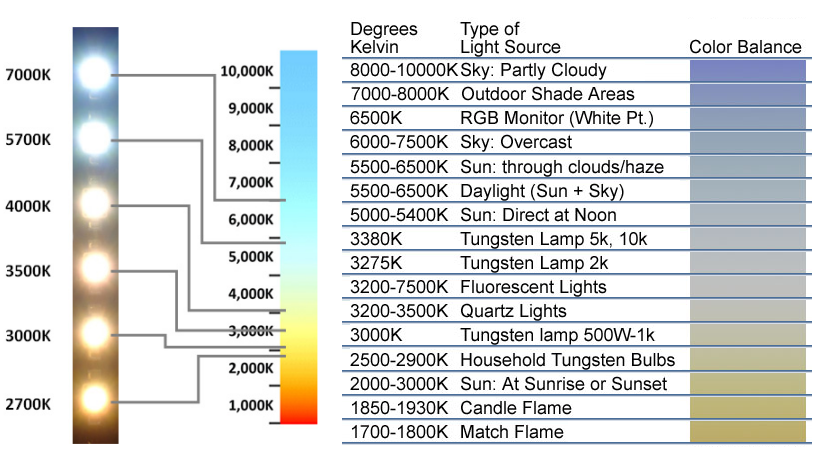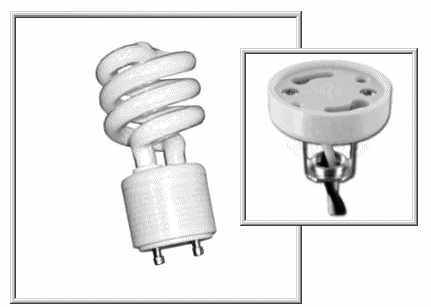The Consumer's Guide to Light Bulbs
When purchasing light bulbs, and consideration when purchasing light fixtures as to what bulbs they use, the consumer needs to be familiar with three very basic principles.
- Light Output
- Color Temperature
- Luminous Efficacy
The consumer will need to know what socket type the bulb uses. Some common socket types are:
- E26/E27 Edison Screw
- GU24 Bayonet
- ....
|
Note: This page is notably incomplete. You can help. Please contribute by registering your email address and adding your knowledge to this page. The D.U.C.K. wiki was created to be a free informative place that allows an open exchange of accurate information. Learn more... |
Contents
Light Bulb Luminous Efficacy
Luminous efficacy is a measure of how well a light source produces visible light. It is the ratio of luminous flux to power. Luminous flux can be defined as the measure of the perceived power of light. The luminous efficacy of a light bulb is a measure of the efficiency with which the light bulb provides visible light from electricity.
Artificial light sources are usually evaluated in terms of luminous efficacy of a source, also sometimes called overall luminous efficacy. The overall luminous efficacy is a measure of the efficiency of the device with the output adjusted to account for the spectral response curve. When expressed in dimensionless form this value may be called overall luminous efficiency, wall-plug luminous efficiency, or simply the lighting efficiency.
The efficacy is effectiveness of the light bulb to product light. The efficiency of the bulb is a measure of how well it produces "visible" light for how many watts consumed. It is the ratio of the visible light delivered for how much energy is supplied.
The Watts for Light Output Consumer Misnomer
The measure of a light bulb's perceived brightness, the luminous out, using the old Watts standard is not wrong. Brightness is a description of light output, which is measured in lumens. Light bulb brightness described by watts should never have been used in the market. Now manufacturers are producing bulbs that are many times more efficient. Efficacy is about the brightness, whereas efficiency is about how much energy is wasted in producing the light output.
Watts is a measurement of the amount of energy required to product light. The higher the watts the more your electric bill goes up. You want a bulb that produces the brightest possible light using the fewest watts. When purchasing a light bulb, you should be considering the lumens so that you can know exactly how bright the light bulb will be.
Tungsten Incandescent Watts to Lumens
Here is a cross-reference based on the light output of old tungsten incandescent light bulb.
- 40-watt incandescent bulb = 450 lumens
- 60-watt incandescent bulb = 800 lumens
- 75-watt incandescent bulb = 1100 lumens
- 100-watt incandescent bulb = 1600 lumens
- 150-watt incandescent bulb = 2600 lumens
To save energy, find the bulbs with the lumens you need, and then choose the one with the lowest wattage. Tungsten Incandescent Light Bulbs are slightly less efficient than Halogen Light Bulbs. Fluorescent Light Technology is more efficient than incandescent and halogen. Considerably more efficient than fluorescent lighting, including CFL (Compact Florescent Lights) are LED Light Bulbs. Modern LED light bulbs product the most lumens for the fewest watts.
Besides considering the brightness and energy consumption of a light bulb you should also consider the Light Color Temperature of the blub. Although color temperature does not have a significant impact on how efficient the bulb produces light, it does have an impact on your perception of what kind of light the bulb produces.
Incandescent Light Bulbs
Incandescent lamps are nearly pure resistive loads with a power factor of 1. This means the actual power consumed (in watts) and the apparent power (in volt-amperes) are equal. The actual resistance of the filament is temperature dependent. The cold resistance of tungsten filament lmaps is about 1/15 the resistance when the lamp is lit. For example, a 100 watt, 120 volt lamp has a resistance of 144 Ω when lit, but the cold resistance is much lower (about 9.5 ohms) [31]. Since incandescent lamps are resistive loads, simple triac dimmers can be used to control brightness. Electrical contacts may carry a "T" rating symbol indicating that they are designed to control circuits with the high inrush current characteristic of tungsten lamps. For a 100-watt 120 volt general service lamp, the current stabilizes in about 0.10 seconds, and the lamp reaches 90% of its full brightness after about 0.13 seconds.
Power
| Power (W) | Output (lm) | Efficacy (lm/W) |
|---|---|---|
| 5 | 25 | 5 |
| 15 | 110 | 7.3 |
| 25 | 200 | 8.0 |
| 35 | 350 | 10.3 |
| 40 | 500 | 12.5 |
| 50 | 700 | 13.5 |
| 55 | 800 | 14.2 |
| 60 | 850 | 14.5 |
| 65 | 1000 | 15.0 |
| 70 | 1100 | 15.7 |
| 75 | 1200 | 16.0 |
| 90 | 1450 | 16.1 |
| 95 | 1600 | 16.8 |
| 100 | 1700 | 17.0 |
| 135 | 2350 | 17.4 |
| 150 | 2850 | 19.0 |
| 200 | 3900 | 19.5 |
| 300 | 6200 | 20.7 |
Light Color Temperature
Color temperature is a measure of a light source radiating color when illuminated, and is measured in degrees Kelvin. The higher the number, the whiter and then bluer, the color.
"Temperature" in this context refers to "appearance" rather than a thermal property for the touch sense. It is simply a way to describe the color characteristics of light, usually either warm (yellowish) or cool (bluish.
The color temperature of a light source is the ideal black-body radiator that radiates light of comparable hue to that of the light source. When a so called black body radiator such as a lamp filament is heated, the filament will begin to glow. As the temperature of the filament increases the color of the light emitted will shift from one end of the spectrum progressively to the other. Color temperatures over 5,000K are called cool colors (bluish white), while lower color temperatures (2,700–3,000 K) are called warm colors (yellowish white through red). This relation, however, is a psychological one in contrast to the physical relation implied by Wien's displacement law, according to which the spectral peak is shifted towards shorter wavelengths (resulting in a more blueish white) for higher temperatures.
Some Standard Light Bulb Socket Types
E26 Edison Screw
In the designation 'Exx', 'E' stands for 'Edison' and 'xx' refers to the diameter in millimeters as measured across the peaks of the thread on the base. In Europe the designation is E27 which is nearly the exact same size.
A19 bulb with E26 base
The most commonly used A-series light bulb with an E26 base is the A19 bulb. The A19 designation refers to the width of the bulb in one-eighth inch units. When speaking about the bulb, we say A19, and the base we say E26.
The common A19 bulb is 2 3/8 inches wide, 4 3/8 inches long, and has a one inch E26 base. These bulbs were originally of the incandescent type, burning a tungsten wire filament to produce light.
GU24
The GU24 socket and base system is designed to replace the Edison socket and base in energy efficient lighting fixtures. The California Energy Commission prohibits adapters that would allow the use of screw-in bulbs on a GU24 base. This is to prevent people from using normal incandescent bulbs.
The GU24 base has two dual-diameter pins. The smaller portion has a diameter of 3.4mm (0.13") and the larger portion has a diameter of 5mm (0.2").
A19 bulb with GU24 base
As explained in Common Residential Light Bulb Socket Types in North America the shape of the bulb as described as A19 represents the common shape that most people are familiar with. The A19 bulb was traditionally available with the E26 Edison Screw base. Now as a result of new Government regulations, it is common to see the A19 bulb with the GU24 socket base system.
Other
|
Note: This page is notably incomplete. You can help. Please contribute by registering your email address and adding your knowledge to this page. The D.U.C.K. wiki was created to be a free informative place that allows an open exchange of accurate information. Learn more... |
All Wiki Lighting Documentation
Category Index: Category:Lighting


